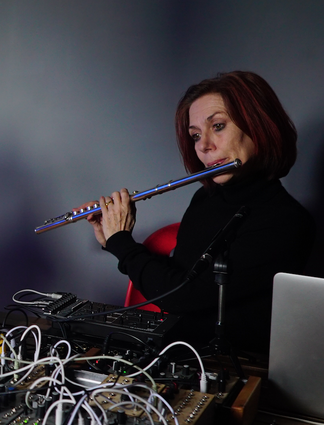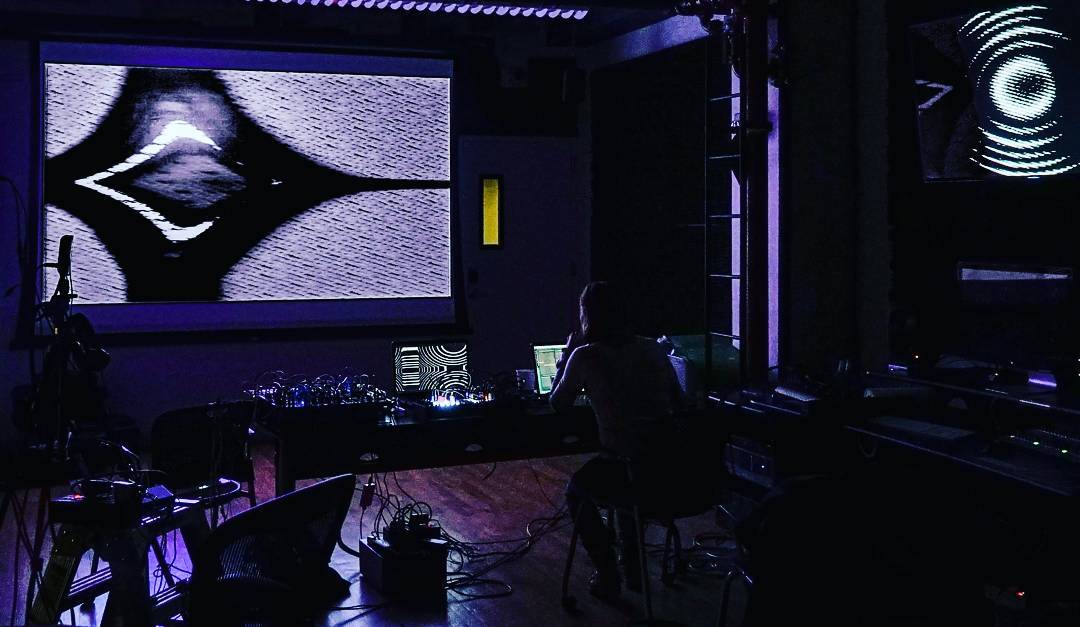
The Third Rail: As one follows the trajectory of your career, the breath, via flute, and then via other operations — both scores and machines — undergoes a transformation or conversion into a different kind of sound. Scores and machines “re-shape the breath,” to tweak Ned Rothenberg’s phrase. For instance, in your very recent work with Benton C Bainbridge, your breath instigates the piece, both through the sound of the flute and in controlling your Moog synthesizer, both of which Benton then modifies for the piece’s audio and video outputs.
Barbara Held: When I was four years old, my mother got sick with polio at the very end of one of the big epidemics. She spent many months in an iron lung, and my younger sister and I were sent to live with relatives far away and not allowed to visit her. When she died, I found something that had become one of my deepest memories: a 2-track reel-to-reel tape that my father had made as a family letter. He recorded my mom in the iron lung, and then everyone in the family added some kind of little message, mostly talking about the hot mid-western weather (it was August), the crops, the corn, the beans. The voices are incredible, including my own child voice singing “In the Good Old Summertime,” but what I remember is mom’s voice, speaking in the rhythm of the iron lung that was making her breathe. I used all that sentimental material in a sound collage piece called Upper Air Observation, but what has impacted me the most was the alarm or fear or whatever feeling it is that stays in that artificial breathing. I guess that it wasn’t a coincidence that I choose an instrument that is so transparently breath-like.
About breath in general, I think, like the Black Mountain artists, that we can’t help making things that come from our natural body rhythms, especially the heart and breath, that are really one thing. One of my favorite sounds is the way string quartets use their breathing to stay together. You’re not supposed to hear it. A composer named Charlie Morrow has a beautiful song setting for solo voice of an English translation by Jerome Rothenberg of Juan de la Cruz’s poem “Dark Night.” The breathing is notated in the score: long breath in, long breath out, musical phrase, breath. He has another fun piece for ocarina that is only the instruction to play each phrase as long as one breath. I performed it while having a gallbladder attack, and the phrases were tiny gasps.
TTR: I would love to hear more about your work with installation, for instance your recent installation with Benton Observatory/Lisa Joy (2016). From what I understand the original Observatory piece uses numerical data as its basis, and is further filtered through an information-based system. In looking at other installation works of yours, so much of it seems to be about mapping or building the particularities of a given space.
BH: My collaboration with Benton is still in process, but I’m really enjoying the directness of the relationship. We are using similar instruments to synthesize and process image and sound (Eurorack video modules and a small Moog synthesizer modulated with acoustic flute sound), and everything is folding back, in and out. He is interested in portraits, so even the images of our hands and faces are going into the mix. His A/V modules make sound or image equally. He can send me audio frequencies that I can use as what’s called a control voltage: information that can be used to modulate the sound I am making. My acoustic flute or my synthesized sounds can go into the mix of what is modulating the images that he is making. In the installation that is part of the Madrid show Escuchar con los ojos: Arte sonoro en España, 1961–2016 (Fundación Juan March, 2016), Benton’s instrument, which he calls Lisa Joy, is a fairly simple extension of the translation of data that creates my generative sound installation and converts one natural phenomenon into another: numeric data of solar oscillations into the math of the harmonic series over a pixel of flute sound. His drawings are not a totally direct interaction with the sound. He creates a calligraphy of shapes and lines with the synthesizer module that then is modified by the sound input from a small mic inside the synthesizer that divides that information into its component frequencies and translates it into changes in the horizontal, vertical, and brightness components of the drawing.
Interestingly, Lisa Joy is named for Lissajous figures, which are named for Jules Antoine Lissajous, a French physicist who developed a method of visualizing waves by using a small mirror on a vibrating object such a tuning fork, which is another of the gadgets I love. (I have a collection of books from the era, by John Tyndall and Spanish equivalents, with these wonderful illustrations. The Royal Society was organizing soirées to demonstrate the new scientific discoveries about the way light and sound work, and they used these apparatuses to demonstrate, which was like something between performance and magic show.)
Right now, Benton and I are working on Pausa, a piece for St. Cloud in March to make an installation that is partially performed, which keeps the seed of the performed sound and video images, and continues to generate new relationships. We’re thinking of ways of using that late winter light and reflection of snow in the gallery window when we make our piece. I started trying to combine performance and installation this last fall when I was asked to participate in the Signal Festival in Cagliari, Sardenya. The theme of the festival was silence, so I proposed to start from zero, playing the flute into a computer patch that recorded and manipulated the sounds, eventually generating sound as an ongoing installation.
Issue 10 of The Third Rail launches on Friday, March 17. The event will feature live music by Feel Free Hi Fi and Zina, video by Mati Diop & Manon Lutanie and Adam Khalil & Zack Khalil, food by The Sioux Chef and Salty Tart. 8:30 – midnight, 147 Holden Street North, Minneapolis. Free.
BARBARA HELD AND BENTON C BAINBRIDGE
AUDIOVISUAL PERFORMANCE FOR FLUTE, SYNTHESIZED AND PROCESSED SOUND AND IMAGE
Studio Z: 275 East Fourth Street, Suite 200, St. Paul
Tickets
Media art collaborations by BENTON C BAINBRIDGE (The Bronx) and BARBARA HELD(NY/Barcelona) pair acoustic and electronic sound with realtime image processing. Their live performances, installations and recordings are composed using audiovisual synthesizers modulated with flute, as well as generative software. Solar seismic activity, the human breath, and other periodic measurements inspire their structural strategies.
Bainbridge/Held's current project is Pausa, a collaborative composition in which sound and image "conduct" each other. The Binary Pattern Generator, a one-of-a-kind modular instrument by Brendan Byrne, generates simple rhythms which are interpreted by a software and hardware A/V synthesis system, triggering variations in the timbre of a live flute performance and layering of abstract forms into moving pictures.
Co-sponsored by The Third Rail.
Monday, March 20, 4:00 PM, Barbara Held and Benton C Bainbridge, Pausa performance and exhibition opening, Kiehle Gallery, Kiehle Visual Art Center, St. Cloud State University, 720 4th Avenue South, St. Cloud, MN, FREE
A live duo performance will initiate an audio-visual installation, in which sound and image from the performance will evolve over a three-week exhibition.
Wednesday, March 22, 4:00 PM, Barbara Held, “Breathing and Its Transformations” solo concert on flute, Ruth Gant Recital Hall, Performing Arts Center, St. Cloud State University, 620 3rd Ave South, St. Cloud, MN, FREE
Barbara Held will perform a program of works composed for her by Alvin Lucier and Yasunao Tone from 1985 to 1990. These pieces feature recently restored custom instruments built by the composers and in several cases have not been performed in 30 years.



 RSS Feed
RSS Feed
